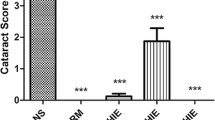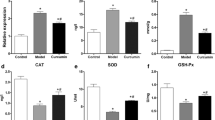Abstract
Cataract is the leading cause of blindness worldwide. It is a multifactorial disease primarily associated with oxidative stress produced by free radicals. The present study was undertaken to evaluate the anticataract potential of Crataegus pinnatifida (hawthorn tree) leaves extract in selenite-induced cataract in vivo and antioxidant effects in vitro. In vitro antioxidant assay of C. pinnatifida leaves extract on NO production inhibition, aldose reductase inhibition, and O -2 radical scavenging activities gave the IC50 of 98.3, 89.7, and 5.98 μg/mL, respectively. To characterize some major compounds in C. pinnatifida leaves extract, nine flavonoids were identified via LC–MS/MS qualitative analysis. Based on in vitro screening results, C. pinnatifida leaves extract eye drops in 0.1% hydroxypropyl methyl cellulose solution were prepared to evaluate the anticataract potential in vivo. Administration of C. pinnatifida leaves extract eye drops alternately three times a day in rat pups with selenite-induced oxidative stress significantly increased serum SOD and CAT activities, and tended to reduce MDA level compared with control group. The antioxidant enzyme SOD, CAT, and GSH activities in lens showed a significant increase. These results may be applied in the future for the prevention and treatment of cataracts.


Similar content being viewed by others
References
JiangsuXinyixueyuan (1977) Dictionary of Traditional Chinese Medicines. Shanghai Scientific and Technologic Press, Shanghai
Melikoglu G, Bitis L, Mericli AH (2004) Flavonoids of Crataegus microphylla. Nat Prod Res 18:211–213
Rayyan S, Fossen T, Nateland HS, Andersen OM (2005) Isolation and identification of flavonoids, including flavone rotamers, from the herbal drug 'Crataegi folium cum flore' (hawthorn). Phytochem Anal 16:334–341
Ying XX, Wang RX, Xu J, Zhang WJ, Li HB, Zhang CS, Li FM (2009) HPLC Determination of Eight Polyphenols in the Leaves of Crataegus pinnatifida Bge. var. major. J Chromatogr Sci 47:201–205
Zhang PC, Xu SX (2003) C-glucoside flavonoids from the leaves of Crataegus pinnatifida Bge. var. major N.E.Br. J Asian Nat Prod Res 5:131–136
Veveris M, Koch E, Chatterjee SS (2004) Crataegus special extract WS (R) 1442 improves cardiac function and reduces infarct size in a rat model of prolonged coronary ischemia and reperfusion. Life Sci 74:1945–1955
Asgary S, Naderi GH, Sadeghi M, Kelishadi R, Amiri M (2004) Antihypertensive effect of Iranian Crataegus curvisepala Lind: a randomized, double-blind study. Drugs Exp Clin Res 30:221–225
Tadic VM, Dobric S, Markovic GM, Dordevic SM, Arsic IA, Menkovic NR, Stevic T (2008) Anti-inflammatory, gastroprotective, free-radical-scavenging, and antimicrobial activities of hawthorn berries ethanol extract. J Agric Food Chem 56:7700–7709
Shearer TR, Ma H, Fukiage C, Azuma M (1997) Selenite nuclear cataract: review of the model. Mol Vis 3:8
Isai M, Sakthivel M, Ramesh E, Thomas PA, Geraldine P (2009) Prevention of selenite-induced cataractogenesis by rutin in Wistar rats. Mol Vis 15:2570–2577
Javadzadeh A, Ghorbanihaghjo A, Arami S, Rashtchizadeh N, Mesgari M, Rafeey M, Omidi Y (2009) Prevention of selenite-induced cataractogenesis in Wistar albino rats by aqueous extract of garlic. J Ocul Pharmacol Ther 25:395–399
Manikandan R, Thiagarajan R, Beulaja S, Chindhu S, Mariammal K, Sudhandiran G, Arumugam M (2009) Anti-cataractogenic effect of curcumin and aminoguanidine against selenium-induced oxidative stress in the eye lens of Wistar rat pups: an in vitro study using isolated lens. Chem Biol Interact 181:202–209
Orhan H, Marol S, Hepsen IF, Sahin G (1999) Effects of some probable antioxidants on selenite-induced cataract formation and oxidative stress-related parameters in rats. Toxicology 139:219–232
Ghanem AA, Arafa LF, El-Baz A (2010) Oxidative stress markers in patients with primary open-angle glaucoma. Curr Eye Res 35:295–301
Ma L, Lin XM (2010) Effects of lutein and zeaxanthin on aspects of eye health. J Sci Food Agric 90:2–12
Chung SS, Ho EC, Lam KS, Chung SK (2003) Contribution of polyol pathway to diabetes-induced oxidative stress. J Am Soc Nephrol 14:S233–S236
Tao W, Deqin Z, Yuhong L, Hong L, Zhanbiao L, Chunfeng Z, Limin H, Xiumei G (2010) Regulation effects on abnormal glucose and lipid metabolism of TZQ-F, a new kind of Traditional Chinese Medicine. J Ethnopharmacol 128:575–582
Matsuda H, Wang T, Managi H, Yoshikawa M (2003) Structural requirements of flavonoids for inhibition of protein glycation and radical scavenging activities. Bioorg Med Chem 11:5317–5323
Matsuda H, Morikawa T, Toguchida I, Yoshikawa M (2002) Structural requirements of flavonoids and related compounds for aldose reductase inhibitory activity. Chem Pharm Bull (Tokyo) 50:788–795
Lindblad BE, Hakansson N, Svensson H, Philipson B, Wolk A (2005) Intensity of smoking and smoking cessation in relation to risk of cataract extraction: a prospective study of women. Am J Epidemiol 162:73–79
Nakagawa T, Yokozawa T, Terasawa K, Shu S, Juneja LR (2002) Protective activity of green tea against free radical- and glucose-mediated protein damage. J Agric Food Chem 50:2418–2422
Silva MM, Santos MR, Caroco G, Rocha R, Justino G, Mira L (2002) Structure-antioxidant activity relationships of flavonoids: a re-examination. Free Radic Res 36:1219–1227
Matsuda H, Morikawa T, Toguchida I, Ninomiya K, Yoshikawa M (2001) Medicinal foodstuffs. XXVIII. Inhibitors of nitric oxide production and new sesquiterpenes, zedoarofuran, 4-epicurcumenol, neocurcumenol, gajutsulactones A and B, and zedoarolides A and B, from Zedoariae Rhizoma. Chem Pharm Bull 49:1558–1566
Srivastava SK, Ramana KV, Bhatnagar A (2005) Role of aldose reductase and oxidative damage in diabetes and the consequent potential for therapeutic options. Endocr Rev 26:380–392
Zhou YJ, Zhang SP, Liu CW, Cai YQ (2009) The protection of selenium on ROS mediated-apoptosis by mitochondria dysfunction in cadmium-induced LLC-PK1 cells. Toxicol in vitro 23:288–294
Manikandan R, Thiagarajan R, Beulaja S, Sudhandiran G, Arumugam M (2010) Curcumin prevents free radical-mediated cataractogenesis through modulations in lens calcium. Free Radic Biol Med 48:483–492
Sakthivel M, Elanchezhian R, Ramesh E, Isai M, Jesudasan CN, Thomas PA, Geraldine P (2008) Prevention of selenite-induced cataractogenesis in Wistar rats by the polyphenol, ellagic acid. Exp Eye Res 86:251–259
Ueda H, Kawanishi K, Moriyasu M (2004) Effects of ellagic acid and 2-(2,3,6-trihydroxy-4-carboxyphenyl)ellagic acid on sorbitol accumulation in vitro and in vivo. Biol Pharm Bull 27:1584–1587
Shearer TR, David LL, Anderson RS (1987) Selenite cataract: a review. Curr Eye Res 6:289–300
Hightower K, McCready J (1994) Selenite-induced damage to lens membranes. Exp Eye Res 58:225–229
Cunha-Vaz JG (1997) The blood-ocular barriers: past, present, and future. Doc Ophthalmol 93:149–157
Mitra AK (2003) Ophthalmic drug delivery systems. Marcel Dekker, New York
Acknowledgement
This research was supported by the Important Drug Development Fund, Ministry of Science and Technology of China (No. 2009ZX09311-002; No. 2009ZX09102-128) and the International Traditional Chinese Medicine Program for Corporation in Science and Technology (No. 2009DFA31070, No. 2007DFC31670).
Author information
Authors and Affiliations
Corresponding author
Rights and permissions
About this article
Cite this article
Wang, T., Zhang, P., Zhao, C. et al. Prevention Effect in Selenite-Induced Cataract in Vivo and Antioxidative Effects in Vitro of Crataegus pinnatifida Leaves. Biol Trace Elem Res 142, 106–116 (2011). https://doi.org/10.1007/s12011-010-8752-8
Received:
Accepted:
Published:
Issue Date:
DOI: https://doi.org/10.1007/s12011-010-8752-8




